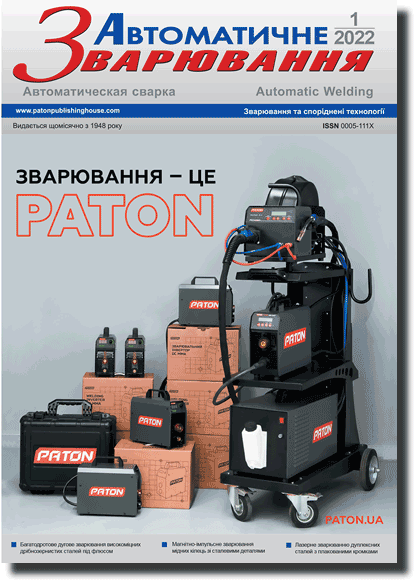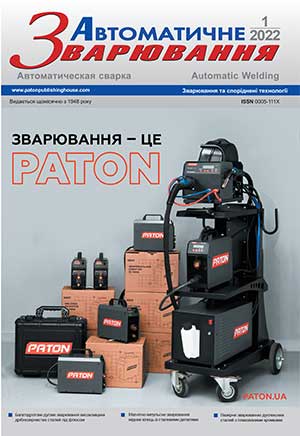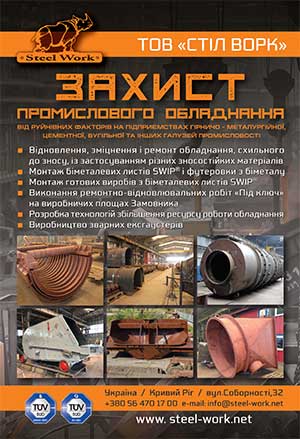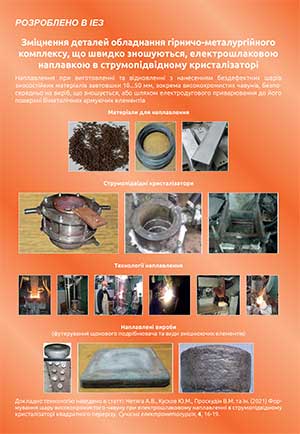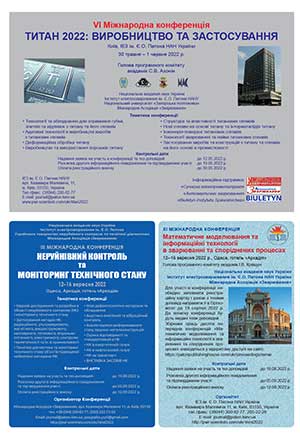| 2022 №01 (07) |
DOI of Article 10.37434/as2022.01.08 |
2022 №01 (01) |
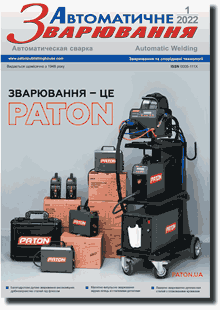
"Avtomatychne Zvaryuvannya" (Automatic Welding), #1, 2022, pp. 49-53
Prediction of weld parameters in esw with a bifilar circuit of power source connection
V.G. Solovyov, Yu.M. Lankin, V.G. Tyukalov, I.Yu. Romanova
E.O. Paton Electric Welding Institute of the NAS of Ukraine. 11 Kazymyr Malevych Str., 03150, Kyiv, Ukraine. E-mail: office@paton.kiev.ua
Electroslag welding with a bifilar power circuit has many positive characteristics. Results of analytical calculations and preliminary research when powering the ESW unit by the bifilar circuit show that there is a real possibility of controlling the process of weld solidification and depth of item edge penetration. In the work, the developed mathematical model was used to conduct a set of mathematical experiments on prediction of the main parameters of weld quality for bifilar ESW with equalizing wire. Such parameters as average value of item edge penetration depth, maximum and minimum edge penetration, base metal share in the weld, metal pool form factor are considered as predicted parameters. Kc parameter characterizing the uniformity of item edge penetration was proposed and analyzed on the model. Nomograms of predicted parameters were derived. 10 Ref., 1 Tabl., 5 Fig.
Keywords: electroslag welding, bifilar circuit, edge penetration depth, metal pool
Received: 9.10.2021
References
1. Medovar, B.I., Stupak, L.M., Bojko, G.A. et al. (1976) Electroslag furnaces. Ed. by B.E. Paton, B.I. Medovar. Kiev, Naukova Dumka [in Russian].2. Jing, Xie (2008) Structure advantage of a 5-t double pole series circuit electroslag furnace. Heavy Casting and Forging, 5(3), 43-45. (In Chinese).
3. Kubin, M., Scheriau, A., Knabl, M. et al. (2013) Operational experience of large sized ESR plants and attainable quality of ESR ingots with diameter of up to 2600 mm. Proceedings of the International Symposium on Liquid Metal Processing & Casting (LMPC). Austin (Texas, USA), 22-25 September (2013), pp. 57-64. https://doi.org/10.1007/978-3-319-48102-9_8
4. Tezuka, M., Yamamoto, S., Takahashi, ? et al. (2014) Internal quality of 2150 mm-diameter ingot manufactured using new 150-ton ESR furnace. Proceedings of the 19th International Forgemasters Meeting (IFM). Tokyo (Japan), 29.09-03.10, 2014, pp. 90-94.
5. Son, I., Lee, W., Sim, Kw. et al. (2014) Installation of 150-ton new ESR facility and production of 120-ton ESR ingot for 12Cr HIP rotor forgings. Ibid, Tokyo (Japan), 29.09-03.10, 2014, pp. 333-337.
6. (1980) Electroslag welding and surfacing. Ed. by B.E. Paton. Moscow, Mashinostroenie [in Russian].
7. Marishkin, A.K. (1984) To problem of calculation of base metal penetration depth in ESR. Avtomatich. Svarka, 3, 71-72 [in Russian].
8. Lankin, Yu.M., Soloviov, V.G., Tyukalov, V.G., Romanova, I.Yu. (2021) Comparison of the processes of electroslag welding at power connection by mono- and bifilar circuits. The Paton Welding J., 11, 22-28. https://doi.org/10.37434/tpwj2021.11.04
9. Lankin, Yu.M., Soloviov, V.G., Tyukalov, V.G., Romanova, I.Yu. (2021) Stability of the process of electroslag welding with bifilar power circuit without equalizing wire. Ibid., 12, 24-28. https://doi.org/10.37434/tpwj2021.12.04
10. Negoda, E.N. (2008) Thermal processes in welding. Vladivostok, Dalnevostochny GTU [in Russian].
Advertising in this issue:
The cost of subscription/purchase order journals or individual articles
| Journal/Currency | Annual Set | 1 issue printed |
1 issue |
one article |
| TPWJ/USD | 384 $ | 32 $ | 26 $ | 13 $ |
| TPWJ/EUR | 348 € | 29 € | 24 € | 12 € |
| TPWJ/UAH | 7200 UAH | 600 UAH | 600 UAH | 280 UAH |
| AS/UAH | 1800 UAH | 300 UAH | 300 UAH | 150 UAH |
| AS/USD | 192 $ | 32 $ | 26 $ | 13 $ |
| AS/EUR | 180 € | 30 € | 25 € | 12 € |
| SEM/UAH | 1200 UAH | 300 UAH | 300 UAH | 150 UAH |
| SEM/USD | 128 $ | 32 $ | 26 $ | 13 $ |
| SEM/EUR | 120 € | 30 € | 25 € | 12 € |
| TDNK/UAH | 1200 UAH | 300 UAH | 300 UAH | 150 UAH |
| TDNK/USD | 128 $ | 32 $ | 26 $ | 13 $ |
| TDNK/EUR | 120 € | 30 € | 25 € | 15 € |
AS = «Automatic Welding» - 6 issues per year;
TPWJ = «PATON WELDING JOURNAL» - 12 issues per year;
SEM = «Electrometallurgy Today» - 4 issues per year;
TDNK = «Technical Diagnostics and Non-Destructive Testing» - 4 issues per year.





